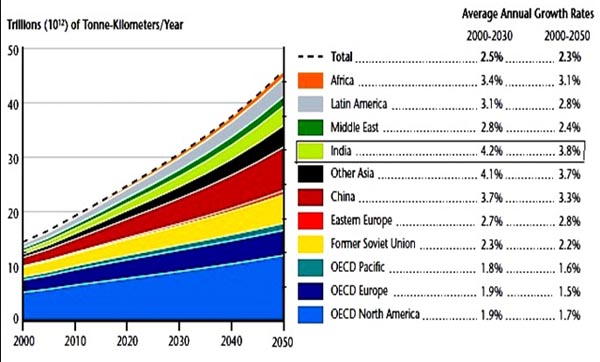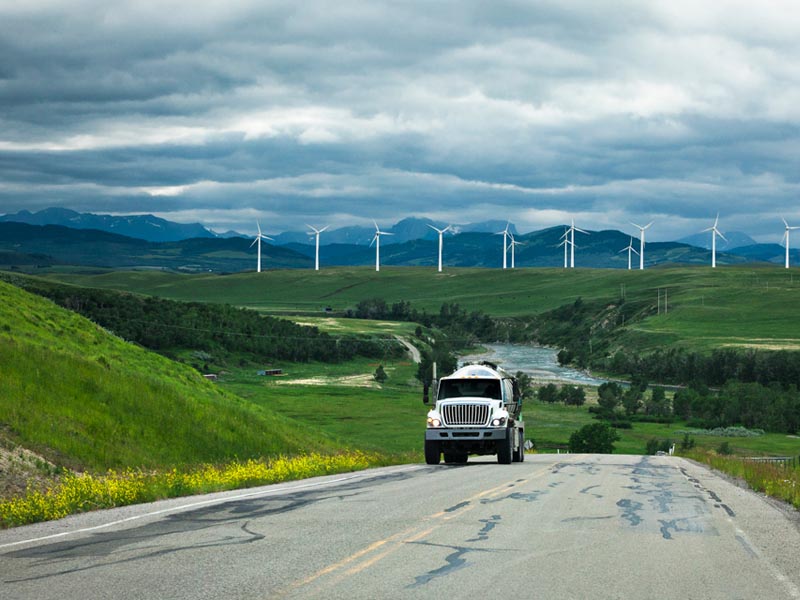‘Going green’ seems to be the new buzzword across the world today. When it comes to greening the freight transport sector of an economy/country, the story indeed gets more interesting. Freight simply means the cargo or goods transported in bulk via road, rail, air or waterways. While transportation and logistics words began being used around 1850 in US; coining of ‘green’ with freight is quite a recent phenomenon across the world. Green Freight fundamentally refers to a methodology consisting of fuel efficiency and emission saving techniques. According to UNCRD (2014), it refers to a set of strategies, policies, practices and standards which inherently aim to drive and create awareness regarding fuel efficient transportation across the supply chain; most importantly reduce environmental, public health impacts of air pollution and heightened intensity of greenhouse gases emissions.
Why does the freight need to go green?
With increase in the economic activities in today’s fast paced globalized world, an increase in freight activities and freight transport emissions per capita is logically expected, as transportation plays a central role in economic development of a country. To make the freight sector more efficient, less pollution causing and more cost effective; globally Green Freight as a movement started in 2004, with the US Environmental Protection Agency “SmartWay” programme. Gradually, over the years, countries like- Germany, Mexico, China have established successful Green Freight Programs which made it visionary for countries like- India, Philippines, Indonesia, etc to pursue it. Further the famous Rio +20 Summit held in 2012 also stressed much on environmentally sustainable transport strategies including green freight as an important investment possibility.
In India’s context, it was in 2012, when a dialogue among stakeholders-involving the Government to freight shippers; civil society organizations to truck developers and concerned NGOs, conclusively led to the formation of the Green Freight India initiative (GFI). Subsequent developments took place gradually like- Clean Air Asia’s Green Trunk Toolkit for purposes as calculating of baseline fuel consumption etc. The Indian Government implemented vehicular emission norms way back in 1991 and at present, Bharat stage emission standards (BS-IV stage since 2010) for pollution control and regulation, based on European norms and standards, are followed.
Admittedly, in India, issues in freight sector have relatively received less attention than other sectors. It is estimated that the freight activity (in billion km) in India is expected to be 9 times higher and the number of trucks 15 times higher in 2050 compared with 2000 level (CAI-Asia and UNCRD 2011). Further, the freight transport activity is projected to grow at 4.2% for India between 2000-2030 (Figure 1).
But the question is, doesn’t the freight pollute? If yes, what kind of management and prevention is being done regarding controlling toxic emissions due to freight movements? Transportation is majority possible by fuel and fuel is a chief cause of pollution. For instance- although trucks constitute only 5% of the total vehicle fleet in India, they contribute 74% to fuel use, carbon emissions (63%), particulate matter emissions (59%) and road accidents (26%.) (CAI-Asia and UNCRD, 2011). Surprisingly enough, even though India spent around 14.4% of its GDP on logistics and transportation as compared to less than 8% spent by the other developing countries (Novonous.com 2016) –the perspective for sustainably developing freight sector is missing. This is where the Green Freight initiatives make a difference.

Opportunities and Challenges facing implementation of Green Freight:
There are many opportunities associated with prominently practising Green Freight in India. For instance- the “Make in India” campaign launched by BJP government in September 2014 is bound to increase freight load and movements manifold through transportation demands as the scheme chiefly focuses on making India a global manufacturing hub gradually. Further, “PCRA (2013) projects that the truck fleet will grow at an average of 8.9 percent every year up to circa 2025.” (Clean Air Asia and GIZ, 2015). So, practising Green Freight would not only break the vicious cycle of problems of inefficiencies, high emissions, and low profitability; but it would convert the ‘vicious’ into a ‘virtuous’ cycle by proactive policies, appropriate technology, sound finance (Bosu 2013); while learning lessons from the forerunner countries’ experiences with Green Freight.
Arguably, challenges amount aplenty for India ‘s freight sector to become economically competitive as well as environmentally sustainable. Some of them include lack of adequate cost-effective technology; lack of skilled and informed drivers; reluctance of banks and financiers to lend money to trucks drivers and small companies; weak institutional framework; fragmented freight sector; lack of publicly available freight data, eventually inhibiting sound road investment and policy planning. (CAI-Asia and UNCRD 2011; Bosu 2013)
Conclusions:
Amidst such promising opportunities and weighing challenges, only consolidated recommendations, can colour the future story of Green Freight ‘positive’ for India. Innovative steps like- “Eco driving”, which involves training and monitoring the vehicle drivers on smarter fuel-efficient driving, should be practised increasingly. Economic interventions like- defining a Green Freight India Fuel Efficiency Index, building the brand; improving fleet management through considering packaging changes–can work immensely. Also, having stricter standards, effective government policies, tracking progress upon established metrics in the implementation process of the roadmap for Green Freight India should be preached. In fact, a stepwise approach with multiple strategies along with maintaining the multi-stakeholders’ and global partnership approach (ADB 2014) should continue. Moreover, developing alternative fuels like-bio diesel, ethanol etc and hence reducing the heavy dependence on conventional fossil fuels are some, but not exhaustive suggestions towards India’s future in Green Freight.
Conclusively, it can be strongly put forth that greening the freight should not be an individual strategy; but it must be integrated as a part of achieving the broader Green Economy strategy where the latter inculcates not just achieving low pollution but also an inclusive growth. In times of rapid climate change, it is high time that India practises Green Freight to tread along the sustainable development trajectory.
References:
- Asian Development Bank (ADB). 2014. “Green Freight and Logistics in Asia: Delivering the Goods, Protecting the Environment.” Accessed as: http://www.adb.org/sites/default/files/publication/42845/green-freight-and-logistics-asia-workshop-proceedings.pdf
- Bosu, Parthaa. 2013. “Smarter Freight Movement through Fuel Efficiency”. Accessed as: http://www.cseindia.org/userfiles/Parthaa%20Bosu.pdf.
- CAI-Asia and UNCRD. 2011. “Best Practices in Green Freight – for an Environmentally Sustainable Road Freight Sector in Asia.” Pasig City, Philippines. Accessed as: http://www.uncrd.or.jp/content/documents/6EST-5A-BGP.pdf
- Clean Air Asia and GIZ. 2015. “Green Freight India: Fuel and Emission Saving Methodology”. Accessed as:http://cleanairasia.org/wp-content/uploads/2015/09/150603_REP_EBTC-GIZ_Green-Freight-India-Report_Final.pdf
- com. 2016. “”Freight Transport Market in India 2015 – 2020″. NOVONOUS. Publication ID: NOV0515001. Accessed as: http://www.novonous.com/publications/freight-transport-market-india-2015-2020.
- United Nations Centre for Regional Development (UNCRD). 2014. “UNCRD’s effort on the promotion of Green Freight under the Regional EST Forum in Asia.” 8th Regional EST Forum in Asia, 19-21 November 2014, Colombo, Sri Lanka. Accessed as: http://www.uncrd.or.jp/content/documents/23628EST-P8_UNCRD.pdf
 |
By Shobhna Jha, (Ph.D. Economics Research Scholar, at IIT Delhi and Kathak Artist) |



Excellent